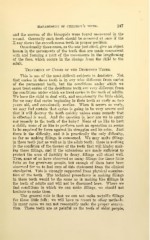Page 393 - My FlipBook
P. 393
MANAGEMENT OF CHILDREN'S TEETH. 247
and the crowns of the bicuspids were found uncovered in the
wound. Generally such teeth should be removed at once if the
X-ray shows the succedaneous teeth in proper position.
Occasionally these cases, as the one just cited, give an object
lesson in the movements of the teeth that are made concurrent
with and forming a part of the movements in the lengthening
of the face, which occurs in the change from the child to the
adult.
Treatment of Caries of the Dech>itol s Teeth.
t
This is one of the most difficult subjects in dentistry. Not
that caries in these teeth is in any wise different from caries
of the permanent teeth, but the conditions under which we
must treat caries of the deciduous teeth are very different from
the conditions under which we treat caries in the teeth of adults.
We have the child to deal with, and occasionally the little child,
for we may find caries beginning in their teeth as early as two
years old, and occasionally earlier. When it occurs so early,
we may feel certain that caries is going to be very severe and
that it will destroy the teeth quickly unless some remedy that
is effectual is used. And the question is, how are we to apply
our remedy to the teeth of the baby? None of us like to hurt
a child ; none of us like to perform such an operation as seems
to be required by force against its struggles and its cries. Just
there is the difficulty, and it is practically the only difficulty,
so far as making fillings is concerned. We may make fillings
in these teeth just as well as in the adult teeth ; there is nothing
in the condition of the tissues of the teeth that will hinder mak-
ing these fillings, and if the extensions are made sufficient to
protect the area of liability to decay, fillings will stand well.
True, none of us have observed so many fillings for these little
folks as for grown-up people, but enough of them have been
observed for us to feel sure of this statement from the clinical
standpoint. This is strongly supported from physical examina-
tion of the teeth. The technical procedures in making fillings
in these teeth would be the same as in making like fillings in
the teeth of adults and will not be discussed here. Where we
find conditions in which we can make fillings, we should not
hesitate to make them.
The general rule is that we can not make metallic fillings
for these little folk; we will have to resort to other methods.
In many cases we can not reasonably make the proper excava-
tion. These teeth are as painful as the teeth of older people,


